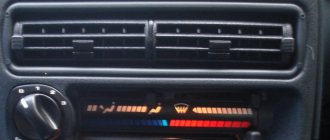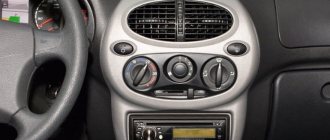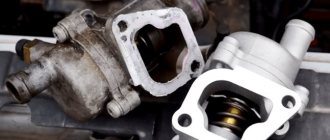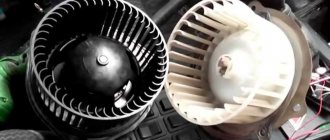The heater is one of the components of the engine cooling system. It provides an influx of fresh air heated to a predetermined temperature into the car interior, making the trip more comfortable for the driver and passengers. All the charm of its work can be felt during the cold season, when the thermometer drops below zero. But, like any mechanism, it has its own resource, which eventually ends. But it can be extended by carrying out regular preventive maintenance.
How to make the stove on a Gazelle Business heat well
The heater is one of the components of the engine cooling system. It provides an influx of fresh air heated to a predetermined temperature into the car interior, making the trip more comfortable for the driver and passengers. All the charm of its work can be felt during the cold season, when the thermometer drops below zero. But, like any mechanism, it has its own resource, which eventually ends. But it can be extended by carrying out regular preventive maintenance.
Operating principle of the heater
A side effect of the engine is heat, which is generated due to fuel combustion and friction of parts. Heat is removed from highly hot parts by the engine cooling system through coolant. It moves along the highways and, having given off heat to the atmosphere, returns back to the internal combustion engine. The coolant movement is provided by a water pump (pump), which operates from the crankshaft pulley via a belt drive. Also, on models with two heaters, an additional electric pump is installed for better coolant circulation throughout the system. To quickly warm up the engine, the system has two circuits (small and large). Between them there is a thermostat, which opens the passage to the large circuit when the coolant reaches the temperature to which it is set. The large circuit has a radiator in its circuit that quickly cools the hot liquid. The heater is included in a small circuit. When operating correctly on a warm engine, the heater blows warm.
The Gazelle Business heater consists of a housing, air ducts with dampers, a radiator, a fan with an impeller, a faucet and a control unit. Hot coolant from the engine enters the stove through the pipes and returns back after heat transfer. For better efficiency, the heater is equipped with an electric motor with an impeller, which blows cold air through the radiator honeycombs and, passing through a heated radiator, the air heats up and enters the cabin already hot. The dampers can be used to direct the flow in the direction we need (on the glass, on the legs, on the face). The temperature is regulated by a tap, which passes a given amount of coolant through the stove. All adjustments are made from the control unit.
Diagnostics
There can be many reasons why the Gazelle Business stove does not work. And for a successful repair, you must first identify the cause of the malfunction, and only then begin to eliminate it:
- The first step is to check the coolant level in the expansion tank. A low coolant level leads to the formation of an air plug in the cooling system, and since the heater is the highest point, the “plug” will be there.
- Next, you need to check the coolant temperature. During the cold season, the engine cools down rapidly before it has time to reach temperature. The temperature sensor may be faulty and show an incorrect temperature value.
- Then you need to check the cabin radiator; it is clogged and may not allow a sufficient amount of coolant to pass through it. You can check this by testing the inlet and outlet pipes; they should be approximately the same temperature. If the inlet pipe is hot and the outlet is cold, then the reason is a clogged radiator.
- If the inlet pipe is also cold, then you need to try the pipe that goes to the radiator from the engine compartment to the tap. If it is hot, then the problem is that the faucet is not working.
- Well, if the pipe to the faucet is cold, then there are more options
- The first thing to check is the thermostat. This can be done with the engine running but not warmed up. We start it and test the surface before and after the thermostat. The surface must be heated before the thermostat, and afterward it must remain cold. If the pipe after the thermostat heats up, then the problem is in the thermostat.
- pump is faulty. It either jammed, or the shaft burst, or the pump impeller became unusable. The fluid does not circulate well through the system, and because of this, the heater may blow cold.
- The gasket between the block and the cylinder head is broken. This malfunction also affects the operation of the heater and the entire engine as a whole. It is accompanied by clouds of white steam from the exhaust pipe and a decrease in coolant in the cooling system. In some cases, antifreeze may be released from the expansion tank.
It's cold in Gazelle business. The stove doesn't heat well. Will replacing the thermostat help?
The Gazelle truck is not just a means of transportation, but a driver’s workplace. And the more comfortable he feels in this place, the further he will be able to travel without experiencing severe fatigue. And if the driver does not get tired while driving, then he makes fewer mistakes and does not endanger himself, the road users around him, or passengers. For commercial vehicles, the issue of comfort should be one of the main priorities, since the driver of such vehicles spends quite a lot of time inside the vehicle. And driving a car with an uncomfortable temperature all day is very difficult. Also, this type of transport is often located outside populated areas, and if any breakdown occurs, it will be very problematic to eliminate the malfunction. Therefore, if you suspect a malfunction of the Gazelle Business stove, you need to carry out detailed diagnostics and make repairs or replacements if necessary.
Why the stove on a gazelle does not work
One of the most common and unpleasant breakdowns on GAZelle cars in winter is a malfunction of the stove. There may be several reasons for this problem. The first thing you should check is whether the heating supply or return pipe . In this case, the hot air will not heat the inside of the car, but the street. If such a breakdown is confirmed, the pipe should be put in its place and secured with a clamp. If none of the pipes has flown off, you need to check their temperature .
The return pipe must be cooler than the supply pipe. However, it is quite difficult to determine the temperature difference between two pipes by touching them with your hand. Another reason for faulty heating of a GAZelle may be a clogged stove radiator , which should be removed and properly purged. The radiator can be clogged both externally with various debris that gets into it when the car is moving, and internally with scale, rust, etc. formed. After dismantling the radiator, you need to pay attention to its temperature. If the radiator is cold, it should be repaired or completely replaced.
If the heating radiator is also in good condition, then it is necessary to check the hoses for the presence of delamination , which may not be noticeable during external inspection. The manufacturer recommends replacing all pipes of the GAZelle car every 3 years.
Reasons why the stove on a GAZelle does not heat up
Also quite common reasons for the non-working condition of the stove on GAZelles are:
• insufficient amount of coolant in the radiator (the most common reason, which can be solved by adding antifreeze or antifreeze to the radiator); • air entering the heating system; • leak formation due to leakage of pipes; • malfunction of the faucet on the stove (it is possible to determine that the cause of the breakdown is in the faucet by rotating the temperature control knob in the car interior and observing the reaction of the regulator itself. It is recommended that two people perform this procedure); • pump breakdown; • thermostat malfunction; • breakage of cable ends; • malfunction of the ignition switch; • burnt fuse; • malfunction of the stove blower motor, which can be eliminated by lubricating it; • the damper lever that turns it inside the stove is broken, or rather its very attachment to the rod that turns the damper; • clogging of the air collector; • cracks on the stove body; • missing or incorrectly installed rubber band in the radiator.
Which radiator is better
When studying the design of the stove for passenger or cargo Gazelles, many owners wonder: which radiator copes better with its functions - aluminum or copper. Let's look at the main advantages of each of these options:
- Aluminum. It has an affordable cost, which can be 2 times lower compared to its copper counterpart. This is precisely the main reason why such products are distributed throughout the globe by manufacturers. Their main drawback is their lower thermal conductivity. The appearance of corroded areas can cause problems with the functioning of the entire heating and cooling system. They cannot be repaired - you have to throw them away and replace them with a new one.
- Copper. They have high thermal conductivity, and this directly affects the quality of interior heating. Copper is easy to solder, and therefore such radiators are repairable. The soldering is smoother and there are no oxides. The disadvantage is the higher selling price.
Experienced mechanics recommend installing a radiator made of copper after a major overhaul. Such a product will last longer, however, dirt particles can get into it, clogging the system. If there is no information about how dirty it is, then you can save money and install aluminum, which is simply washed during use.
Tees with temperature sensors were cut into the upper pipes
It is more difficult to cut and solder the threaded part for the sensor into the radiator itself. However, the mechanics of our GAZelles installed sensors in the upper radiator pipe (this way there is less fiddling). As a result, the fan turns on earlier than necessary - at a lower temperature. At the same time, the engine warms up somewhat worse, and since it is equipped with electronically controlled fuel injection, errors in the operation of the fuel system may occur - an enriched mixture will be prepared. This will lead to increased fuel consumption. In addition, it is possible that the upper pipe is hot, but there is no fluid circulation through the radiator. But the sensor “will not understand” this - the fan will turn on and work completely pointlessly, in addition, the load on the electrical wiring will increase, and the cyclicity of the relay and sensor contacts will become higher. Correct installation of the sensor in the lower pipe of the UMZ-4216 engine allows you to obtain a more stable temperature regime of the engine.
What to do if the stove on the Gazelle stops heating?
One of the most unpleasant winter breakdowns is the failure of the Gazelle’s standard heating system. All drivers diagnose this breakdown with the amazing ease inherent in the most experienced auto mechanics. This is understandable - it simply becomes a little cold in the cabin. The cars of the Gorky Automobile Plant have always been famous for their maintainability, and modern Gazelles are no exception. Let's see what we can do if such a misfortune happens to our car? First of all, we check the inlet and outlet pipes; most often they are the cause of failure, and the air heated by the engine blows into the engine compartment, instead of blowing into the cabin. This problem can be solved simply by putting the pipes back on and tightening them with clamps. If the original clamp is lost, we go to the nearest construction supply store and buy a new one for 30 rubles.
If it's not too cold outside or if you're in a garage, you can try comparing the temperatures of the two pipes by touch. The output should be slightly colder than the input. If this is the case, let's try to blow out the heater radiator; to do this we will have to remove it. This is not difficult at all, since it is held on by only two bolts. If you remove the radiator from a recently shut down car and it is not hot, most likely this is the cause and you will have to buy a new one. Nowadays, it is most convenient to order spare parts from the GAZ online spare parts store, which works directly with the plant. This is both cheaper and faster than searching small shops for the availability of the required spare part. By the way, the radiator should be purged periodically and simply for preventive purposes.
If everything is fine with the radiator, let's check if the heating system hoses are damaged. If the car is already “aged”, it may be worth replacing them completely. Finally, if all the elements except the heater itself are diagnosed, then the reason is its failure. The new heater can be found there - in the GAZ online spare parts store. We begin the procedure by draining the antifreeze. Then we unscrew the radiator and remove the pipes to clean the area where the radiator is located. Checking the radiator damper. The only unpleasant moment that you may encounter when installing a new heater is a mismatch between the holes in the new heater and in the wall of the engine compartment. In this case, you may have to use a grinder and a drill to make new holes. If the old pipes are sealed, we can put them on the new stove.
The main malfunctions that reduce the efficiency of the Gazelle stove:
Alternative reasons
The Gazelle car is quite multi-component. Yes, in most cases, the situation when the heating system does not work well, or the stove does not heat at all, the reason will lie in one of the reasons considered.
But there is always room for exceptions to the rules. In addition, as the practice and experience of owners of such commercial vehicles as the Gazelle shows, sometimes problems come from where you don’t expect them at all.
Therefore, you, as Gazelle drivers, should learn about several more potential reasons that could lead to failure or reduced efficiency of the interior heating system:
- Airing the system. This issue was partially raised, but in the context of problems with coolant. In fact, air locks can occur for various reasons. But most often it is the fault of the driver himself.
- Depressurization and violation of the integrity of pipes. The quality of the pipes that are installed on the Gazelle from the factory can hardly be called high. Therefore, as they are used, they can become deformed, crack and provoke the formation of a leak, contributing to the depressurization of the entire cooling system.
- Broken stove tap. The Gazelle furnace equipment uses mechanical (outdated version) and more modern electric furnace taps. They are responsible for blowing outside air through or bypassing the heated heater core, thereby supplying hot or cold air into the cabin. It is better to check the functionality of the faucet together. One will turn the regulator in the cabin, and the second will observe changes from the engine compartment.
- Broken cable ends. If we are talking about a stove with a cable drive, we certainly cannot exclude the possibility of their breaking or stretching. You will have to remove the assembly, check the condition, change the cables or tighten them.
- Damper malfunction. Under certain circumstances, the dampers may stop in the closed position, not allowing hot air into the cabin, and not open. The breakdown may be associated with the damper drive, or with a faulty jumper between these dampers.
- Clogged air intakes. In order for cold or hot air to enter the Gazelle car interior, the system takes it from the environment. A special air intake is provided for this. If it becomes clogged at the inlet, air simply will not be able to flow into the cabin in the required volume. Hence the result in the form of a poorly functioning stove. Although in fact all the heater elements work normally.
- Cracks have formed in the stove body. The result of incorrect repairs, incorrect assembly after dismantling, the consequences of natural wear and tear, accidental mechanical damage. If the seal of the heater housing is broken, some of the heat can quickly escape, thereby making the cabin cold, even when the heater is turned on to maximum.
Despite the impressive list of potential malfunctions, the stove in Gazelle cars fails mainly due to the natural wear and tear of individual elements, or due to the reason behind the wheel of the car.
Most problems can be prevented and avoided through timely diagnosis, replacement of consumables and proper monitoring of the operation of all components and systems of your vehicle.
Also, owners of Gazelles, like all other cars, are strongly recommended to perform a preventive start of the interior heater at least several times during the warm season. And before the cold starts, go through the entire system, assess the condition of key components, replace or lubricate something, depending on the specific situation. To paraphrase a popular saying about preparing a sleigh in the summer, we note that it is really better to prepare the stove in advance before serious cold weather strikes. Repairing a heater when it's -20 outside is an extremely dubious pleasure.
201005251656_no_copyright_201004191851_63
— Initially, the design of our engine did not provide for an electric coupling; the fan rotated constantly and was installed on the water pump. The electric coupling for turning on the engine cooling fan was installed at the initiative of GAZ. The GAZ designers did not intend to install an electric fan motor, as is done on most cars, since this required a more powerful generator. After all, the GAZelle minibus version is equipped with additional heaters and lamps. Another advantage of the electric coupling is its quiet operation; partly thanks to it, the GAZelle passed noise tests with a reserve.
Why the stove on a Gazelle may not heat up and what should the driver do?
The domestic auto industry has something to appreciate and something to scold for. Russian-made cars have approximately the same number of advantages and disadvantages.
Among commercial vehicles, the Gazelle occupies a special place. Like any other car, the Gazelle is prone to developing certain malfunctions. But the undeniable advantage is that with such a machine almost all problems can be solved with your own hands.
Before the onset of cold weather, it is especially important to check how the heating system works and whether the driver can get the required amount of heat in the cabin by starting the stove during the frost period. Quite often it happens that the heater does not heat, the heated air does not blow well from the air ducts, or even when the engine is already well warmed up, completely cold outside air enters the cabin.
Main possible malfunctions
To accurately determine why the gazelle stove does not heat or does not work efficiently enough, diagnostic measures should be carried out.
Practice clearly shows that there are several reasons and factors due to which the heater stops blowing or simply does not work at full capacity from time to time.
The most common malfunctions of the heating system on Gazelle cars are associated with:
In order for the heating system to start blowing hot air again and under high pressure, depending on the set regulator on the control panel, appropriate work must be carried out to eliminate the identified faults.
Design
On the Gazelle Business, the control of the interior heating system is combined and is carried out both manually using levers and using push-button control from the instrument panel.
The heating operation scheme is standard - air enters through the frontal air intakes by being sucked in by a fan with an electric motor, after which it passes through a system of deflectors and enters directly into the car cabin.
Coolant flow into the heater radiator
is controlled by a damper, the angle of which is driven by an electric motor. The electric motor of the damper drive is Italian-made, which does not at all guarantee against its breakdown, which often happens to it on this Gazelle brand.
Engine control
The damper tap is operated in automatic mode and depends on the set air temperature at the outlet. The design of the stove also includes a damper, which is controlled by an electrically driven gearmotor and can direct part of the air flow bypassing the radiator.
This is one of the main differences between the heater of the Business model and later Gazelles, on which the angle of the dampers was changed using a cable system.
The imperfection and ill-conceived design of the heater leads to the fact that when the stove on a Gazelle Business does not heat, it takes a long time to look for the cause of the malfunction. If the car is under warranty, the best option would be to contact a service station.
Checking the electromagnetic clutch of the car fan BJ1044
When the radiator fan stops spinning, you don’t need to immediately run to the store to buy a new one, you need to determine the cause of the malfunction; perhaps it can be easily eliminated, or perhaps it is not the fan itself that is to blame. How to check the electromagnetic clutch of a BJ1044 car, read the instructions.
When checking the functionality of the fan clutch
When the engine is warm, avoid contact with heated engine parts.
To check the functionality of the coupling, you need to connect the wire to the positive and short it to the wire that comes out of the pump, that is, when the circuit is closed and opened, the electromagnet should click, this will mean that the pump is in working condition.
The same applies to checking the old pump, in this case you need to short the housing to negative and the wire to positive; if nothing clicks, it means that the electric coupling is not working.
Do not check the clutch with the engine running.
The following is a diagram of the activation and control of the electric coupling.
Gray with a black stripe – standard wiring (minus), yellow – power supply to the electric coupling relay
Parameters of the electromagnetic clutch of the ZMZ-405 pump:
Procedure for checking the electromagnetic fan clutch:
Attention: carry out all work under point 4 with the engine stopped!
cold air is blowing from the gazelle stove, fix it in 2 minutes
To watch online, click on the video ⤵
The stove does not heat, Gazelle doors. ZMZ-406 More details
The stove on the GAZELLE does not heat well. Solution! More details
Gazelle, one of the reasons for a cold stove Read more
The Gazelle business stove does not heat. Are looking for! More details
IT'S COLD IN GAZELLE. the secret of a modified stove. More details
5 reasons for the poor performance of the stove on a GAZELLE Read more
Gazelle Cummins heater blows cold air. Gas breakthrough in the cylinder head Read more
Why is it cold in the car? Solution to one of the problems. More details
The stove in the Gazelle doesn't work? what to do? More details
Gazelle stove, why it doesn’t heat, its repair part 2 Read more
The stove does not blow on the gazelle windshield Read more
Gazelle Non-Business, the stove does not work. We are looking for the reason. More details
Gazelle Business - Repair of heater blower dampers Read more
The Gazelle 402 stove does not work Read more
Efficient operation of the stove in cold weather. How to heat the air in the cabin faster. More details
The gazelle stove does not blow on the glass. Repair without removing the panel. More details
Design
On the Gazelle Business, the control of the interior heating system is combined and is carried out both manually using levers and using push-button control from the instrument panel.
The heating operation scheme is standard - air enters through the frontal air intakes by being sucked in by a fan with an electric motor, after which it passes through a system of deflectors and enters directly into the car cabin.
Coolant flow into the heater radiator
is controlled by a damper, the angle of which is driven by an electric motor. The electric motor of the damper drive is Italian-made, which does not at all guarantee against its breakdown, which often happens to it on this Gazelle brand.
Engine control
The damper tap is operated in automatic mode and depends on the set air temperature at the outlet. The design of the stove also includes a damper, which is controlled by an electrically driven gearmotor and can direct part of the air flow bypassing the radiator.
This is one of the main differences between the heater of the Business model and later Gazelles, on which the angle of the dampers was changed using a cable system.
The imperfection and ill-conceived design of the heater leads to the fact that when the stove on a Gazelle Business does not heat, it takes a long time to look for the cause of the malfunction. If the car is under warranty, the best option would be to contact a service station.
The carrier replaced the couplings with casings with electric fans
The rest of the assembly should also not be taken lightly. For example, on the GAZ conveyor (in relation to the ZMZ-406 engine), the fan switch sensor is installed in the left radiator tank, where the temperature of the liquid is lower than in the right one, since it has time to cool while passing through the radiator channels, the liquid enters the right tank directly from the engine cooling jacket. It is better and more correct to install a tee with a sensor on the UMZ-4216 in the lower pipe (it is already detachable), at the inlet to the water pump.
The stove does not heat, six main reasons. What to do
Today a very relevant article (especially in winter) is that the car’s heater does not heat, or heats very poorly! Why does this happen and what are the main reasons for this? After all, a normal working car should warm up the interior within 10 - 15 minutes (unless, of course, you have a turbocharged engine). If after 15 minutes you have barely warm air (or not at all), and all the glass inside is frozen, then this is not “good”! Read my tips below...
First, let's think about how a car warms up? As we all know, during operation the internal combustion engine heats up very much, this happens from the friction of the pistons against the cylinder walls, as well as from the combustion of the fuel mixture. If you do not cool the engine, it will quickly fail (the pistons will simply jam). A whole cooling system has been made from pipes, pipes and radiators, which prevents the power unit from overheating. So one of the radiators is located inside the cabin, under the instrument panel. Without going into complex technical details, this heater radiator (warmed up by engine coolant) warms up your interior. And in order for the heating efficiency to increase significantly, there is a fan nearby (which has several operating modes, faster slower) that blows on this stove, due to which warm air flows intensively into the cabin (both on the windows and on passengers).
There are about five reasons for poor heating of the stove.
Fan doesn't work
The most common reason is that the fan does not work, the stove does not blow, and, accordingly, warm air does not flow well into the cabin, or rather does not flow at all. Of course, the heater radiator will heat up, but for heating the entire cabin, this is extremely insufficient.
The fan or the electronics that control it need to be replaced. Or look at the fuse, often it simply blows and needs to be replaced .
Insufficient coolant level
This is now unlikely, because many modern cars have antifreeze level sensors. However, such cases do occur (say, in cars of previous generations). Imagine - the antifreeze or antifreeze (maybe due to leaking radiators or pipes), the heater does not receive enough heated liquid, and it is practically cold, the fan is blowing, and the air from the heater is cold (it simply does not heat). You need to add coolant to the level ( read how to do this here ). Also, if radiators or pipes are leaking, then the leak must be eliminated.
It is worth noting that when the coolant leaks, “air plugs” may form, so even if you add antifreeze - antifreeze, you need to wait a while for the air to come out.
Heater radiator is clogged
There may be several reasons:
The first is improper mixing of antifreeze and antifreeze . For example, in G13 you filled in, say, G11 or even antifreeze, then a sediment may appear that will quickly clog all the thin radiator pipes.
Secondly, they poured water. Water not only causes rusting of metals in the system, but also forms scale on the walls.
Third, they eliminated leaks in the heater radiator or main radiator using all kinds of sealants. On the one hand we heal, on the other we cripple. The passages in the radiator of the stove can be clogged with excess of this sealant, the liquid cannot circulate normally in it, and therefore heat it up, which means the stove does not really heat. True, your engine may show high temperatures, at the limit level (the main thing is not to overheat it). You need to either flush the system, clean the heater radiator, or simply replace the radiator.
Engine thermostat faulty
Now about more complex breakdowns. If everything is fine with the stove itself, the fan works, but the stove does not heat well, then the problem may be in the engine thermostat.
The thermostat serves to regulate the so-called “cooling circles” of the engine. When we start the engine, the coolant circulates in a “small circle”; the engine and the interior heater are involved here. Thus, heating of the liquid occurs much faster. After the liquid has warmed up, the thermostat opens a “large circle” and the heated liquid has already flowed to the main engine radiator, which is located under the hood. This is done in order not to overheat the engine if the liquid is overheated.
The only solution is to replace the thermostat! Moreover, the faster, the better; nevertheless, the glass in your cabin will also not thaw, which is fraught in winter, because visibility deteriorates.
Repair
After diagnostics, we begin repairs:
- If the coolant level is below the minimum mark, then it must be brought to normal, having first eliminated fluid leaks, if any. It is possible to remove the plug by pushing the pipes along their entire length with the engine running. Or by placing the front of the car downhill and increasing the engine speed to 3,000 rpm. There is also a way to pump the system with air pressure. You need to remove the upper pipe from the expansion tank and lower it into an empty canister. Next, bring the coolant level to the full tank and, by connecting a hand pump to the vacated fitting, pump air into the tank to the lower mark. Then drain the antifreeze from the canister back into the tank and repeat the procedure. This should be repeated 2 – 3 times.
- If the pipes are barely warm and the sensor shows 90° C, then most likely either it or the temperature gauge itself is faulty. They need to be replaced. In extreme cold (more than -20), you can close part of the radiator (no more than 50%), then the engine will heat up better and cool down more slowly.
- To repair the radiator, it must be removed and washed. If washing does not bring results, then you need to replace it with a new one.
- The faucet may not work due to the drive, or the locking mechanism itself may be faulty. On the Gazelle Business, the faucet turns the electric drive. Therefore, you need to first check the drive, and if it is working, start replacing the faucet. It either does not open completely or is completely stuck in one position, and this can cause a cold air flow.
- To replace the thermostat, you need to drain the coolant, unscrew the cap and replace it with a new one, since this mechanism cannot be repaired.
- The pump also needs to be dismantled and replaced with a new one. This is a very important element, and due to its incorrect operation, the entire engine may fail, since coolant circulation is disrupted and heat cannot be effectively removed from highly heated parts. And, as a result, they overheat and become deformed.
- The worst thing that can happen in a broken gasket is water hammer. When the piston tries to compress the liquid, an increased load is placed on all the internal combustion engine mechanisms, which leads to failure of the entire engine, so such a malfunction must be corrected immediately. In this case, it is prohibited to continue moving using engine power. Such repairs are carried out only with the involvement of specialists, since the cylinder head needs to be grooved; everything else can be done on your own.
There are many reasons why the Gazelle Business stove does not work. But with correct diagnostics and timely repairs, it is possible to fix the problem with your own hands and with a small financial investment.











